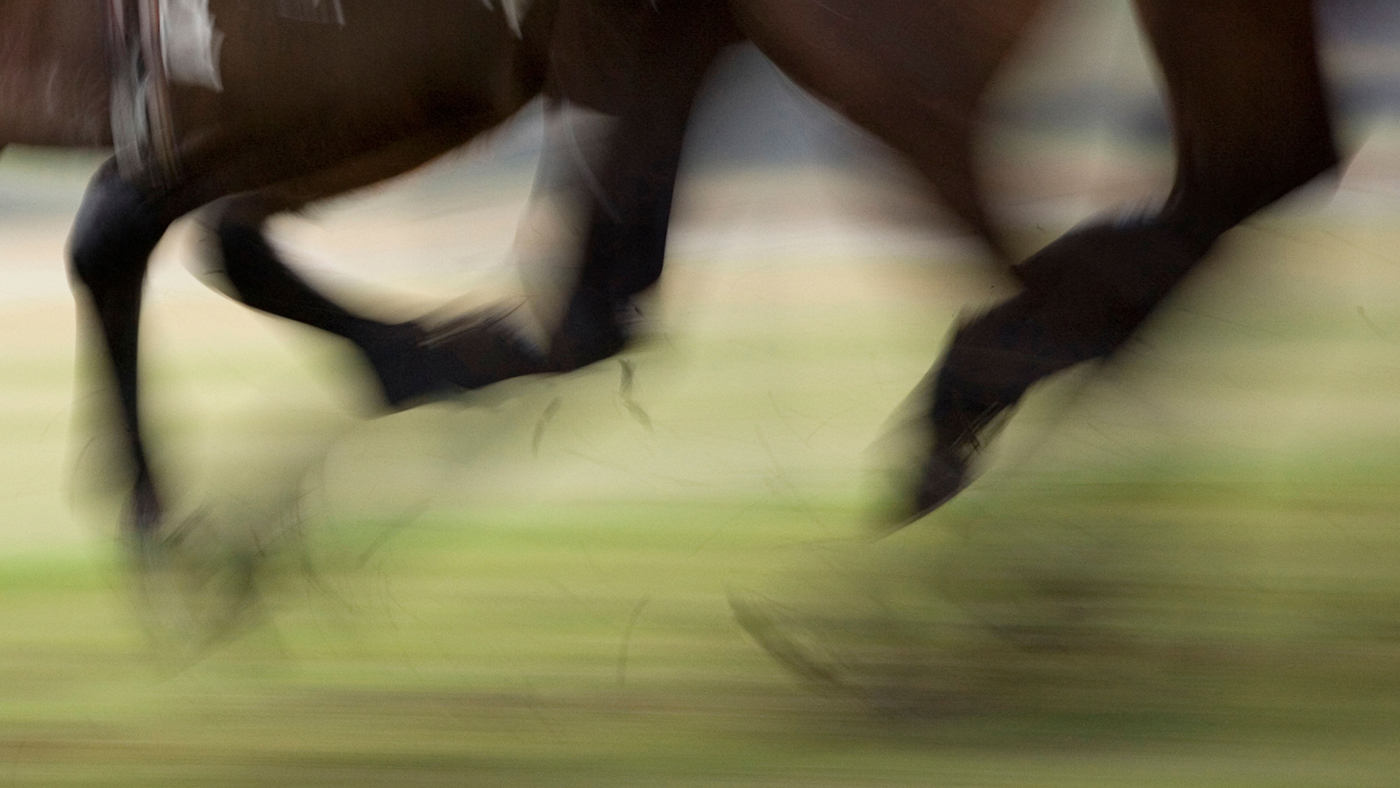With some smart bloodlines in his breeding, Rebecca Friend’s young warmblood/Irish Sport Horse gelding has the potential for a successful competition career. Yet Rebecca’s hopes were put on hold last year when six-year-old Sam experienced difficulty when asked to move backwards.
“I first noticed the problem on the yard, when I pushed him back and saw him hold out a hindleg and shake it,” she says. “It quite surprised me. I bought Sam as a four-year-old and backed him myself — nothing untoward has happened to him and I’d never seen him do this before.”
{"content":"PHA+V2hlbiBzaGUgcmVhbGlzZWQgdGhhdCBTYW0gbWlnaHQgYmUgYSBzaGl2ZXJlciwgYWxhcm0gYmVsbHMgc3RhcnRlZCByaW5naW5nIGluIFJlYmVjY2HigJlzIGhlYWQu4oCcSSBoYWQgaG9wZWQgdGhhdCBoZSB3b3VsZCBvbmUgZGF5IHJlcGxhY2UgbXkgY3VycmVudCBjb21wZXRpdGlvbiBob3JzZSzigJ0gc2hlIHNheXMsIGFkZGluZyB0aGF0IGhlciBmYXJyaWVyIGhhZCBtZW50aW9uZWQgdGhhdCBTYW0gc2VlbWVkIOKAnHRpZ2h04oCdIGJlaGluZCB3aGVuIGJlaW5nIHNob2QuPC9wPgo8cD7igJxIb3dldmVyLCBpZiBoZSBjb3VsZG7igJl0IHBlcmZvcm0gcmVpbi1iYWNrLCB0aGVuIGhlIHdvdWxkIHN1cmVseSBoYXZlIGxpdHRsZSBmdXR1cmUgaW4gZHJlc3NhZ2Ugb3IgaGlnaC1sZXZlbCBldmVudGluZy48L3A+CjxwPuKAnFRoZSBzaGl2ZXJzIGFjdGlvbiB3YXMgcXVpdGUgZXh0cmVtZSBhbmQgd291bGQgdXBzZXQgaGltLOKAnSBzYXlzIFJlYmVjY2EsIGRlc2NyaWJpbmcgaG93IFNhbSB3b3VsZCBzbGlkZSBhIGhpbmRsZWcgb3V0IGFuZCBob2xkIGl0IGFzIGlmIGl0IHdhcyDigJxsb2NrZWTigJ0uPC9wPgo8cD48ZGl2IGNsYXNzPSJhZC1jb250YWluZXIgYWQtY29udGFpbmVyLS1tb2JpbGUiPjxkaXYgaWQ9InBvc3QtaW5saW5lLTIiIGNsYXNzPSJpcGMtYWR2ZXJ0Ij48L2Rpdj48L2Rpdj48c2VjdGlvbiBpZD0iZW1iZWRfY29kZS0zMSIgY2xhc3M9ImhpZGRlbi1tZCBoaWRkZW4tbGcgcy1jb250YWluZXIgc3RpY2t5LWFuY2hvciBoaWRlLXdpZGdldC10aXRsZSB3aWRnZXRfZW1iZWRfY29kZSBwcmVtaXVtX2lubGluZV8yIj48c2VjdGlvbiBjbGFzcz0icy1jb250YWluZXIgbGlzdGluZy0tc2luZ2xlIGxpc3RpbmctLXNpbmdsZS1zaGFyZXRocm91Z2ggaW1hZ2UtYXNwZWN0LWxhbmRzY2FwZSBkZWZhdWx0IHNoYXJldGhyb3VnaC1hZCBzaGFyZXRocm91Z2gtYWQtaGlkZGVuIj4NCiAgPGRpdiBjbGFzcz0icy1jb250YWluZXJfX2lubmVyIj4NCiAgICA8dWw+DQogICAgICA8bGkgaWQ9Im5hdGl2ZS1jb250ZW50LW1vYmlsZSIgY2xhc3M9Imxpc3RpbmctaXRlbSI+DQogICAgICA8L2xpPg0KICAgIDwvdWw+DQogIDwvZGl2Pg0KPC9zZWN0aW9uPjwvc2VjdGlvbj48L3A+CjxwPuKAnEkgd29uZGVyZWQgaWYgaGUgaGFkIGFueSBmdXR1cmUgYXQgYWxsLuKAnTwvcD4KPGgzPlNoaXZlcnMgc2lnbnM8L2gzPgo8cD5XaGlsZSBzaGl2ZXJzIGhhcyBiZWVuIHJlY29nbmlzZWQgZm9yIG1hbnkgeWVhcnMsIEFsZXggRHJhcGVyIE1SQ1ZTLCBmcm9tIFRoZSBRdWVlbuKAmXMgVmV0ZXJpbmFyeSBIb3NwaXRhbCBmb3IgQW5pbWFscywgVW5pdmVyc2l0eSBvZiBDYW1icmlkZ2UsIGV4cGxhaW5zIHRoYXQgdGhlcmUgaXMgc3RpbGwgY29uZnVzaW9uIGFzIHRvIGV4YWN0bHkgd2hhdCBjbGluaWNhbCBzaWducyBhcmUgYXNzb2NpYXRlZCB3aXRoIHRoZSBkaXNlYXNlIGFuZCwgaW1wb3J0YW50bHksIHdoYXQgY2F1c2VzIGl0LiBUaGUgZGVmaW5pdGlvbiB3YXMgc3RhbmRhcmRpc2VkIGluIDIwMTUuPC9wPgo8cD7igJxQcmltYXJpbHksIG9uZSBvciBib3RoIGhpbmRsaW1icyBhcmUg4oCUIG9mdGVuIHRvIGRpZmZlcmluZyBkZWdyZWVzIOKAlCBwaWNrZWQgdXAgYW5kIGhlbGQgb3V0IHRvIG9uZSBzaWRlICh0ZXJtZWQgaHlwZXJmbGV4aW9uIGFuZCBhYmR1Y3Rpb24pLCBvciBhcmUgZXhjZXNzaXZlbHkgcmlnaWQgKHRlcm1lZCBoeXBlcmV4dGVuc2lvbiks4oCdIHNheXMgQWxleCwgYWRkaW5nIHRoYXQgdGhlcmUgaXMgZnJlcXVlbnRseSB0YWlsIGVsZXZhdGlvbiwgdHdpdGNoaW5nIG9mIGZhY2lhbCBtdXNjbGVzIGFuZCBlYXJzLCBhbmQgaGluZGxpbWIgbXVzY2xlIHRyZW1ibGluZy48L3A+CjxkaXYgY2xhc3M9ImFkLWNvbnRhaW5lciBhZC1jb250YWluZXItLW1vYmlsZSI+PGRpdiBpZD0icG9zdC1pbmxpbmUtMyIgY2xhc3M9ImlwYy1hZHZlcnQiPjwvZGl2PjwvZGl2Pgo8cD7igJxOb3JtYWwgaG9yc2VzIHdhbGsgYmFja3dhcmRzIHdpdGggYSB0d28tYmVhdCBnYWl0OiByaWdodCBmcm9udCBsZWcgd2l0aCBsZWZ0IGhpbmQsIHRoZW4gbGVmdCBmcm9udCBsZWcgd2l0aCByaWdodCBoaW5kLCBidXQgdGhpcyBwYXR0ZXJuIGlzIGxvc3QgaW4gaG9yc2VzIGFmZmVjdGVkIHdpdGggc2hpdmVycyzigJ0gc2hlIHNheXMuPC9wPgo8cD7igJxJbiB0aGUgbWFqb3JpdHkgb2YgY2FzZXMsIHRoZSBob3JzZSB3aWxsIG1vdmUgZm9yd2FyZHMgd2l0aCBhIG5vcm1hbCBnYWl0IGluIHdhbGssIHRyb3QsIGNhbnRlciBhbmQgZ2FsbG9wLiBQaWNraW5nIHVwIGhpcyBoaW5kIGZlZXQgYXQgc3RhbmRzdGlsbCBjYW4gYmUgZGlmZmljdWx0LCBob3dldmVyLCB3aXRoIGVpdGhlciBoeXBlcmZsZXhpb24gb3IgaHlwZXJleHRlbnNpb24gb2NjdXJyaW5nLiBUaGlzIG9mdGVuIGlzIHRoZSBmaXJzdCBzaWduIHRoZSBvd25lciBub3RpY2VzLjwvcD4KPGRpdiBjbGFzcz0iYWQtY29udGFpbmVyIGFkLWNvbnRhaW5lci0tbW9iaWxlIj48ZGl2IGlkPSJwb3N0LWlubGluZS00IiBjbGFzcz0iaXBjLWFkdmVydCI+PC9kaXY+PC9kaXY+CjxwPuKAnEEgbWlsZGx5IGFmZmVjdGVkIGhvcnNlIG1heSBiZSByZWx1Y3RhbnQgdG8gd2FsayBiYWNrd2FyZHMgYW5kIGlzIHR5cGljYWxseSB1bmFibGUgdG8gYmFjayB1cCBpbiBhIHN0cmFpZ2h0IGxpbmUsIHBlcmhhcHMgc2hvd2luZyBtdXNjbGUgdGVuc2VuZXNzIG9yIHRyZW1ibGluZyBvdmVyIHRoZSBoaW5kbGltYnMgYW5kIGluZnJlcXVlbnQsIHN1ZGRlbiBhbmQgZXhjZXNzaXZlIGZsZXhpb24gb3IgZXh0ZW5zaW9uLOKAnSBhZGRzIEFsZXguIOKAnEEgc2V2ZXJlbHkgYWZmZWN0ZWQgaG9yc2UgbWF5IGJlIGltcG9zc2libGUgdG8gYmFjayB1cC4gSGUgbWF5IHN0cnVnZ2xlIHRvIGxpZnQgaGlzIGhpbmQgZmVldCBhbmQgbWF5IGV2ZW4gaGF2ZSBkaWZmaWN1bHR5IHN0YW5kaW5nIHVwIGFmdGVyIGx5aW5nIGRvd24uPC9wPgo8cD7igJxJbiByYXJlIGFuZCBleHRyZW1lIGNhc2VzLCBob3JzZXMgaGF2ZSBzaG93biBoeXBlcmZsZXhpb24gYW5kIGFiZHVjdGlvbiBvZiB0aGUgaGluZGxpbWJzIHdoZW4gZmlyc3Qgd2Fsa2luZyBmb3J3YXJkcy7igJ08L3A+CjxkaXYgY2xhc3M9ImFkLWNvbnRhaW5lciBhZC1jb250YWluZXItLW1vYmlsZSI+PGRpdiBpZD0icG9zdC1pbmxpbmUtNSIgY2xhc3M9ImlwYy1hZHZlcnQiPjwvZGl2PjwvZGl2Pgo8cD5UaGUgZGlhZ25vc2lzIG9mIHNoaXZlcnMgaXMgYmFzZWQgZW50aXJlbHkgdXBvbiByZWNvZ25pdGlvbiBvZiBjbGFzc2ljYWwgY2xpbmljYWwgc2lnbnM7IHRoZXJlIGlzIG5vIGJsb29kIHRlc3Qgb3IgaW1hZ2luZyBhdmFpbGFibGUuPC9wPgo8cD7igJxJbiBhZGRpdGlvbiwgdGhlIGV4YWN0IGNhdXNlIGhhcyBub3QgYmVlbiBmdWxseSBlbHVjaWRhdGVkLOKAnSBzYXlzIEFsZXguIOKAnERlZ2VuZXJhdGlvbiBvZiB0aGUgY2VyZWJlbGx1bSAodGhlIGFyZWEgb2YgdGhlIGJyYWluIHRoYXQgY29udHJvbHMgY29vcmRpbmF0aW9uIGFuZCBiYWxhbmNlKSBhbmQgYWJub3JtYWwgaGluZGxpbWIgbXVzY2xlIGdyb3VwIHJlY3J1aXRtZW50IGhhdmUgYm90aCBiZWVuIGlkZW50aWZpZWQgaW4gYWZmZWN0ZWQgaG9yc2VzLCBzdHJvbmdseSBzdWdnZXN0aW5nIHRoaXMgaXMgYSBuZXVyb2xvZ2ljYWwgZGlzb3JkZXIgcmF0aGVyIHRoYW4gYSBwcmltYXJ5IG11c2NsZSBkaXNlYXNlLiBCdXQgZnVydGhlciB3b3JrIGlzIG5lY2Vzc2FyeS7igJ08L3A+CjxwPkFsZXggZXhwbGFpbnMgdGhhdCBtb3N0IGNhc2VzIGFyZSByZXBvcnRlZCB0byBvY2N1ciB3aXRoIGFuIGluc2lkaW91cyBvbnNldCwgd2l0aCBubyBhcHBhcmVudCBjYXVzZSwgaW4gaG9yc2VzIG9mIGZpdmUgeWVhcnMgb2xkIG9yIG1vcmUuIFRocmVlLXF1YXJ0ZXJzIG9mIGNhc2VzIHByb2dyZXNzIGluIHNldmVyaXR5LjwvcD4KPHA+4oCcUG9seXNhY2NoYXJpZGUgc3RvcmFnZSBteW9wYXRoeSAoUFNTTSkgd2FzIG9uY2UgY2xhaW1lZCB0byBjYXVzZSBzaGl2ZXJzIHNpZ25zLCBidXQgdGhpcyBoYXMgYmVlbiByZWZ1dGVkLOKAnSBzaGUgYWRkcy4g4oCcUmFyZWx5LCBhY3V0ZSwgc2V2ZXJlIHNpZ25zIGFyZSByZXBvcnRlZCB0byBvY2N1ciBpbiBwcmV2aW91c2x5IG5vcm1hbCBob3JzZXMgYWZ0ZXIgZXh0cmVtZSB0cmF1bWEsIHN1Y2ggYXMgZmFsbGluZyBvbiBpY2UsIHdoaWNoIGFiYXRlIHdpdGggYXBwcm9wcmlhdGUgdmV0ZXJpbmFyeSBjYXJlIGFuZCB0aW1lLjwvcD4KPHA+4oCcTWFsZSBob3JzZXMsIHBhcnRpY3VsYXJseSBvZiAxNi4zaGggb3IgbW9yZSwgYXBwZWFyIHRvIGJlIG1vcmUgY29tbW9ubHkgYWZmZWN0ZWQsIGFsdGhvdWdoIHNtYWxsZXIgaG9yc2VzIGFuZCBtYXJlcyBkbyBkZXZlbG9wIHRoZSBkaXNlYXNlLOKAnSBzYXlzIEFsZXguIOKAnFdpdGggaGVpZ2h0IGFwcGVhcmluZyB0byBiZSBhIHJpc2sgZmFjdG9yLCBicmVlZHMgc3VjaCBhcyBkcmF1Z2h0IGhvcnNlcywgd2FybWJsb29kcyBhbmQgdGhvcm91Z2hicmVkcyBhcmUgbW9zdCBmcmVxdWVudGx5IHJlcHJlc2VudGVkLiBEdWUgdG8gdGhpcyBicmVlZCBwcmVkaWxlY3Rpb24sIHNoaXZlcnMgaGFzIGJlZW4gdGhvdWdodCB0byBoYXZlIGEgZ2VuZXRpYyBwcmVkaXNwb3NpdGlvbiwgYnV0IG5vIGdlbmV0aWMgdGVzdCBoYXMgeWV0IGJlZW4gZGV2ZWxvcGVkLuKAnTwvcD4KPGgzPlN0cmluZ2hhbHQgZXhwbGFpbmVkPC9oMz4KPHA+TWFueSBob3JzZXMgaHlwZXJmbGV4IGEgaGluZGxpbWIsIG9mdGVuIHdpdGggZXhjZXNzaXZlIG11c2NsZSB0d2l0Y2hpbmcgYW5kIHR5cGljYWxseSBkdXJpbmcgc2hvZWluZywgc28gQWxleCBzdHJlc3NlcyB0aGUgaW1wb3J0YW5jZSBvZiBydWxpbmcgb3V0IGRpc29yZGVycyB0aGF0IGNhbiBwcm9kdWNlIHRoZSBzYW1lIGNsaW5pY2FsIHNpZ25zIGFzIHNoaXZlcnMuPC9wPgo8cD7igJxIb3JzZXMgd2l0aCBob2NrIHBhaW4gb3Igc3VzcGVuc29yeSBsaWdhbWVudCBpbmZsYW1tYXRpb24gaGF2ZSBzaG93biBzaW1pbGFyIHNpZ25zLOKAnSBzaGUgc2F5cy4g4oCcUmVtZW1iZXIsIGlmIGEgaG9yc2UgY2FuIHdhbGsgYmFja3dhcmRzLCBpdCBpcyBoaWdobHkgdW5saWtlbHkgaGUgaGFzIHNoaXZlcnMu4oCdPC9wPgo8cD5Bbm90aGVyIG5ldXJvbXVzY3VsYXIgY29uZGl0aW9uIGNvbW1vbmx5IGNvbmZ1c2VkIHdpdGggc2hpdmVycyBpcyBzdHJpbmdoYWx0LjwvcD4KPHA+4oCcU3RyaW5naGFsdCBjYW4gYmUgaWRpb3BhdGhpYywgb2NjdXJyaW5nIHNlZW1pbmdseSB3aXRob3V0IGFueSBjYXVzZSwgb3Igc2Vjb25kYXJ5IHRvIHRveGluIGluZ2VzdGlvbizigJ0gZXhwbGFpbnMgQWxleC4g4oCcVGhlIGxhdHRlciBpcyBrbm93biBhcyBBdXN0cmFsaWFuIG9yIHRveGljIHN0cmluZ2hhbHQgYW5kIHRlbmRzIHRvIGFmZmVjdCBtYW55IGhvcnNlcyBncmF6aW5nIHRoZSBzYW1lIGNvbnRhbWluYXRlZCBwYXN0dXJlIG9yIGhheS48L3A+CjxwPuKAnFRoZSBkaXNlYXNlIGlzIGNoYXJhY3RlcmlzZWQgYnkgZXhjZXNzaXZlLCByYXBpZCBmbGV4aW9uIG9mIG9uZSBvciBib3RoIGhpbmRsaW1icywgd2hpbGUgdGhlIGhvcnNlIHdhbGtzIGZvcndhcmRzIGFuZCBiYWNrd2FyZHMsIHdoaWNoIGlzIGRpZmZlcmVudCB0byBtb3N0IHNoaXZlcnMgY2FzZXMs4oCdIHNoZSBhZGRzLiDigJxUaGUgaGluZGxpbWIgZmxleGlvbiBjYW4gYmUgbWlsZCwgYW5kIGFzeW1tZXRyaWNhbCwgb3IgdmlvbGVudCB3aGVyZSB0aGUgZmV0bG9jayBjb250YWN0cyB0aGUgaG9yc2XigJlzIHVuZGVyc2lkZSBhbmQgY2F1c2VzIGEg4oCYYnVubnkgaG9wcGluZ+KAmSBnYWl0LiBCdXQgZmFjaWFsIHR3aXRjaGluZyBhbmQgdGFpbCBoZWFkIGVsZXZhdGlvbiBhcmUgYWJzZW50LjwvcD4KPHA+4oCcVW5saWtlIHNoaXZlcnMsIHNpZ25zIG9mIHN0cmluZ2hhbHQgYXJlIG9ic2VydmFibGUgYXQgdHJvdCDigJQgYW5kIHN0cmluZ2hhbHQgc3VmZmVyZXJzIG1heSBhbHNvIGhhdmUgb3RoZXIgc2lnbnMgb2YgbmV1cm9sb2dpY2FsIGR5c2Z1bmN0aW9uLCBzdWNoIGFzIGxhcnluZ2VhbCBwYXJhbHlzaXMgKHdoaWNoIGlzIGtub3duIGFzIHJvYXJpbmcpLjwvcD4KPHA+4oCcT3RoZXIgY29uZGl0aW9ucyB0aGF0IGNhdXNlIGplcmt5LCBleGNlc3NpdmUgZmxleGlvbiBvZiB0aGUgaGluZGxpbWJzIGluY2x1ZGUgdXB3YXJkIGZpeGF0aW9uIG9mIHRoZSBwYXRlbGxhIChvZnRlbiB0ZXJtZWQgbG9ja2luZyBvZiB0aGUgc3RpZmxlIG9yIGtuZWUpLCBmaWJyb3RpYyBteW9wYXRoeSBvciBhIHJhcmUgZGlzZWFzZSBjYWxsZWQgc3RpZmYtaG9yc2Ugc3luZHJvbWUs4oCdIEFsZXggZXhwbGFpbnMuIOKAnEFkZGl0aW9uYWxseSwgZXF1aW5lIG1vdG9yIG5ldXJvbmUgZGlzZWFzZSwgY2F1c2VkIGJ5IGEgbGFjayBvZiB2aXRhbWluIEUsIGhhcyBiZWVuIHJlcG9ydGVkIHRvIHJlc2VtYmxlIHNvbWUgb2YgdGhlIHNoaXZlcnMgc2lnbnMgYnV0IHdpdGhvdXQgdGhlIGNoYXJhY3RlcmlzdGljIGdhaXQgY2hhbmdlcy7igJ08L3A+CjxoMz5XaGF04oCZcyB0aGUgcHJvZ25vc2lzPzwvaDM+CjxwPlRvIGRhdGUsIHRoZXJlIGlzIG5vIGVmZmVjdGl2ZSB0cmVhdG1lbnQgZm9yIHNoaXZlcnMuPC9wPgo8cD7igJxTZXZlcmUgY2xpbmljYWwgc2lnbnMgbWF5IGltcHJvdmUsIGVzcGVjaWFsbHkgd2l0aCBpbmNyZWFzZWQgdHVybm91dCBhbmQgbWlsZCBleGVyY2lzZSwgYnV0IG1heSByZWN1ciBkdXJpbmcgcGFpbmZ1bCBvciBzdHJlc3NmdWwgc2l0dWF0aW9ucyBzdWNoIGFzIHRoZSBkZXZlbG9wbWVudCBvZiBsYW1pbml0aXMs4oCdIHNheXMgQWxleC4g4oCcSWYgZmFycmllcnkgYmVjb21lcyBhIHByb2JsZW0sIGFzayB5b3VyIHZldCBhYm91dCBzZWRhdGlvbiB3aXRoIGFuIGFscGhhLTIgYWdvbmlzdCBtZWRpY2F0aW9uIHdoaWNoIGNhbiB0ZW1wb3JhcmlseSBhbGxldmlhdGUgc3ltcHRvbXMuIFNob3VsZCBibG9vZCB0ZXN0cyByZXZlYWwgbG93IHZpdGFtaW4gRSBsZXZlbHMsIHN1cHBsZW1lbnRhdGlvbiBpcyBhZHZpc2FibGUgYXMgdGhpcyBhbnRpb3hpZGFudCBzdXBwb3J0cyBtdXNjbGUgaGVhbHRoLjwvcD4KPHA+4oCcVGhlIHByb2dub3NpcyBhcHBlYXJzIHRvIGJlIGNhc2UgZGVwZW5kZW50LOKAnSBzaGUgYWRkcy4g4oCcSW4gc29tZSBob3JzZXMgdGhlIGNvbmRpdGlvbiBwcm9ncmVzc2VzIHF1aWNrbHksIGJ1dCB0aGUgY29udHJhcnkgaXMgYWxzbyB0cnVlLiBNYW55IGVxdWluZSBhdGhsZXRlcyB3aG8gaGF2ZSBzaGl2ZXJzIGNhbiBwZXJmb3JtIGF0IGEgaGlnaCBsZXZlbC7igJ08L3A+CjxoMz7igJhIZSBpcyBjb3BpbmcgYSBsb3QgYmV0dGVy4oCZPC9oMz4KPHA+V2l0aCBoZWxwIGZyb20gY2hpcm9wcmFjdG9yIE9saXZpYSAoTGlsKSBKb25lcywgUmViZWNjYSBpcyBub3cgbW9yZSBvcHRpbWlzdGljIGFib3V0IFNhbeKAmXMgcHJvc3BlY3RzLjwvcD4KPHA+4oCcTGlsIGhhcyBlbmNvdXJhZ2VkIG1lIHRvIG1hbmFnZSB0aGUgcHJvYmxlbSBieSBrZWVwaW5nIGhpbSBtb3ZpbmcgYW5kIHdvcmtpbmcgaW4gdGhlIGNvcnJlY3Qgd2F5LOKAnSBzaGUgZXhwbGFpbnMuIOKAnEhlIGlzIHF1aXRlIGhpZ2hseSBzdHJ1bmcgYW5kIGNhbiBiZSBhIGJpdCBzdHJlc3NlZCBpbiB0aGUgc3RhYmxlLCBzbyBoZSBub3cgbGl2ZXMgaW4gYSByb29teSBjb3dzaGVkIGFuZCBoYXMgcGxlbnR5IG9mIHR1cm5vdXQuIEhlIGlzIGFsc28gb24gYSBoaWdoLWZpYnJlLCBsb3ctc3RhcmNoIGRpZXQsIHdoaWNoIGlzIHRob3VnaHQgdG8gaGVscC48L3A+CjxwPuKAnEFmdGVyIGxvdHMgb2YgcHJhY3RpY2UgYXQgbW92aW5nIGJhY2t3YXJkcyBpbi1oYW5kLCBTYW0gaXMgZmFyIGxlc3MgYW54aW91cyzigJ0gc2F5cyBSZWJlY2NhLiDigJxIaXMgcmlkZGVuIHdvcmsgaXMgYmV0dGVyLCB0b28sIGFuZCB3ZeKAmXJlIHN0YXJ0aW5nIHNvbWUgZ3JpZHdvcmsu4oCdPC9wPgo8cD5MaWwgZXhwbGFpbnM6IOKAnEhvcnNlcyB3aXRoIHNoaXZlcnMgY2FuIGJlY29tZSBhbnhpb3VzIGFib3V0IHBpY2tpbmcgdXAgdGhlaXIgaGluZGxlZ3MgYW5kIG1vdmluZyBzaWRld2F5cyBvciBiYWNrd2FyZHMsIHdoaWNoIGNhbiB3b3JzZW4gdGhlIHByb2JsZW0gYW5kIGxlYWQgdG8gdGVuc2lvbiBhbmQgc3RhYmlsaXNhdGlvbiBpc3N1ZXMgdGhyb3VnaCB0aGUgcmVzdCBvZiB0aGUgYm9keS4gVGhlIGFpbSBpcyB0byBoZWxwIGNvb3JkaW5hdGUgbW92ZW1lbnQgaW4gdGhlIGhvcnNl4oCZcyBicmFpbiwgdGVhY2hpbmcgaGltIHRvIGxpZnQgaGlzIGxlZ3MgY2FsbWx5IGluLWhhbmQgYW5kIHVzaW5nIGZsYXR3b3JrIGV4ZXJjaXNlcyBzdWNoIGFzIHRyb3R0aW5nIHBvbGVzIChwaWN0dXJlZCwgcmlnaHQpIHRvIGVuY291cmFnZSB0aGlzIG1vdmVtZW50LjwvcD4KPGRpdiBjbGFzcz0iaW5qZWN0aW9uIj48L2Rpdj4KPHA+4oCcSSBhbHNvIHVzZSBoYW5kcy1vbiB0ZWNobmlxdWVzIHRvIHJlc3RvcmUgYW5kIGhlbHAgbWFpbnRhaW4gbm9ybWFsIG1vdmVtZW50IHRocm91Z2ggU2Ft4oCZcyBzcGluZS4gSXTigJlzIGltcG9ydGFudCB0aGF0IGhlIHVzZXMgY29yZSBtdXNjbGVzIGZvciBzdXBwb3J0IGFuZCBsaWZ0cyBjb3JyZWN0bHkgdGhyb3VnaCBoaXMgd2l0aGVycywgd2l0aG91dCBvdmVyLSBvciB1bmRlci13b3JraW5nIGFueSBhcmVhcy4gSGUgaGFzIHJlZ3VsYXIgc2Vzc2lvbnMgYW5kIGlzIGNvcGluZyBhIGxvdCBiZXR0ZXI7IG5vdCBiZWluZyB0b28gcmVzdHJhaW5lZCBpcyBiZW5lZmljaWFsIGZvciBoaXMgYm9keSBhbmQgYnJhaW4sIGFuZCBoZSBzZWVtcyBoYXBwaWVyIGFuZCBsZXNzIHN0cmVzc2VkLuKAnTwvcD4KPHA+PGVtPlJlZiBIb3JzZSAmYW1wOyBIb3VuZDsgMjMgSmFudWFyeSAyMDIwPC9lbT48L3A+CjxwPgo="}
This site is protected by reCAPTCHA and the Google Privacy Policy and Terms of Service apply.
